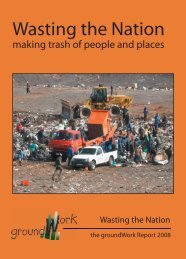Waste Incineration: A Dying Technology - GAIA
Waste Incineration: A Dying Technology - GAIA
Waste Incineration: A Dying Technology - GAIA
You also want an ePaper? Increase the reach of your titles
YUMPU automatically turns print PDFs into web optimized ePapers that Google loves.
source of dioxins in the environment. European Union (EU) data indicate that most dioxin from<br />
incinerators is released to land, rather than to the air. 36 One study found that only 1.7 percent of<br />
an incinerator’s dioxin releases went out the stack, with the vast majority released in ash and<br />
slag. 37<br />
Other Halogenated Organic Compounds<br />
In addition to dioxins, incinerators are sources of other halogenated organic compounds. 39<br />
These include polychlorinated biphenyls (PCBs), chlorinated benzenes, polychlorinated<br />
naphthalenes (PCN), halogenated phenols, brominated and mixed halogenated dioxins,<br />
iodinated dioxins, polychlorinated dibenzothiophenes and many aza-heterocyclic<br />
compounds. 40 In general, these substances have been much less studied than dioxins, and less<br />
is known about their releases and their health effects. Some of these substances, namely<br />
hexachlorobenzene (HCB) and PCBs, are listed as<br />
Persistent Organic Pollutants (POPs) under the Stockholm<br />
Convention; many are known or suspected carcinogens,<br />
and several are thought to have dioxin-like toxicity.<br />
Mercury<br />
Like dioxins, mercury is a persistent,<br />
bioaccumulative toxin that can be transported far from<br />
where it is emitted into the environment. Since it is an<br />
element, mercury cannot be broken down. It is a potent<br />
neurotoxin, which means it attacks the body’s central<br />
nervous system, resulting in disturbances in sensation<br />
(tingling and numbness), impaired vision, speech, and<br />
motor control, spasms, loss of memory, and even death.<br />
Mercury also attacks the heart, kidney and lungs. It is particularly hazardous to developing<br />
fetuses, infants and young children, with effects including delayed development of motor<br />
functions (walking, talking and speaking), mental retardation, seizure disorders, cerebral palsy,<br />
blindness and deafness. Mercury transfers from women to fetuses across the placenta and to<br />
infants through breastfeeding, resulting in exposure at critical stages of development. 42<br />
Incinerators, and medical waste incinerators in particular, are major sources of mercury<br />
pollution. In the United States, approximately 39 percent of airborne mercury emissions are<br />
from waste incinerators; the global average is approximately 29 percent. 43 Once released into<br />
the environment, mercury is readily transformed into methylmercury, which easily enters the<br />
food chain and bioaccumulates.<br />
Mercury contamination is widespread. In the United States, the Centers for Disease Control<br />
estimate that 375,000 children — about one-tenth of all births — are born each year with an<br />
elevated risk of neurological impacts because of low-level mercury exposures during the<br />
pregnancy. 44<br />
“The emissions from incinerator processes are extremely toxic. Some of the<br />
emissions are carcinogenic. We know, scientifically, that there is no safe threshold<br />
below which we can allow such emissions. We must use every reasonable instrument<br />
to eliminate altogether.”<br />
— U.K. Environment Minister Michael Meacher to a House of Lords<br />
Inquiry, 1999. 45<br />
16 <strong>Waste</strong> <strong>Incineration</strong>: A <strong>Dying</strong> <strong>Technology</strong><br />
“POPs have been linked<br />
to numerous adverse effects<br />
in humans and animals.<br />
Those include cancer,<br />
central nervous system<br />
damage, reproductive<br />
disorders and immune<br />
system disruptions. They<br />
are, in fact, lethal.”<br />
— USEPA Administrator<br />
Christie Whitman, 2001. 41

















